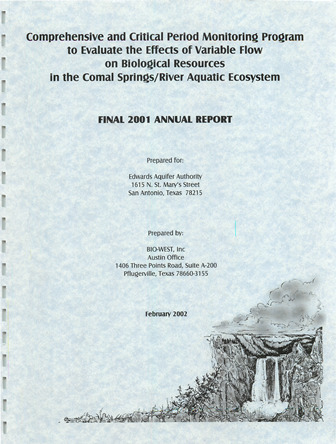Comprehensive and Critical Period Monitoring Program to Evaluate the Effects of Variable Flow on Biological Resources in the Comal Springs/River Aquatic Ecosystem Final 2001 Annual Report

| Summary |
|
The purpose of this report is to document the results of all aquatic ecosystem monitoring conducted in 2001 at Comal Springs located in New Braunfels, Texas. The monitoring and report preparation was performed by BIO-WEST, Inc. Pflugerville, Texas. [Excerpted from the Executive Summary] Throughout this time period the Comal ecosystem can be characterized as an ecosystem with very high water quality for the chemical and physical variables that were measured…. Aquatic vegetation remained abundant throughout the study period and provided suitable habitat for biological communities…. Fountain darters were collected from each reach sampled reach during each sampling event. The overall size class distribution for the Comal ecosystem represents that of a healthy fish assemblage… By all indications the densities of giant ramshorn snails (Marisa cornuarietis) observed in the Comal ecosystem during the study period to date (including the 2000 low-flow events) pose no serious threat to the aquatic vegetative community. However, because of the impact that this exotic species can have under heavier densities, close monitoring of this species should continue. The gill parasite that has been reported for the fountain darter was evident in a number of collected fountain darters. … Within the spring runs and at the springs’ orifices, suitable habitat for the listed invertebrates was observed throughout the study period. Several Comal Springs riffle beetle (Heterelmis comalensis) adults and larvae were collected in the drift nets throughout the year. A major discovery in 2001concerning invertebrates was the extension of the known range for the Comal Springs riffle beetle. … Suitable habitat for the Comal Springs salamander (Eurycea sp.) was noted in the spring runs and Spring Island area with Comal Springs salamanders observed in each area for each sampling event. … One conclusion that can be made is that this study is the most comprehensive biological evaluation that has ever been conducted on the Comal ecosystem. |
Search for Documents
Advance Search
Explore EAA's Scientific Reports
- All Reports
- Weather Modification
- Geology
- Water Use and Conservation
- Geochemistry
- Water Resources Planning and Management
- Floods and Drought
- Water Quality
- Climatology
- Surface Water / Groundwater Relationship
- Biology
- Springs, Groundwater Discharge
- Archaeology
- RZ Protection
- Aquifer Levels
- Remote Sensing
- Precipitation
- Overview Studies
- Modeling
- Hydrology and Hydrogeology
- History
- Groundwater Recharge, Recharge Zone
- Groundwater Movement
- Geomorphology and Caves
